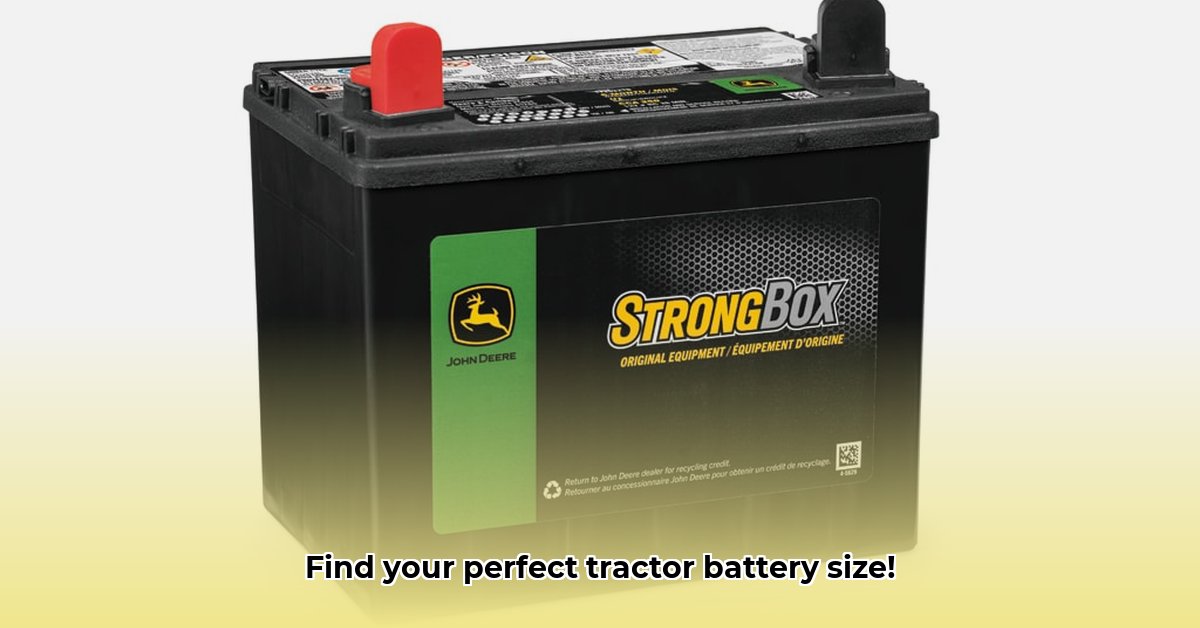
Understanding Farm Tractor Battery Size Charts
Choosing the right battery for your farm tractor is crucial for reliable starts and extended equipment lifespan. A poorly chosen battery can lead to frustrating breakdowns, costly repairs, and lost productivity. This guide provides a clear, step-by-step process to help you find the perfect fit for your tractor, maximizing uptime and minimizing downtime. We'll decode battery specifications, illustrate how to use size charts effectively, and cover installation and maintenance best practices. For example, see this guide for Ford 600 tractor battery information: Ford 600 Battery Guide.
Decoding Battery Specifications: CCA, Ah, RC, and Group Size
Before selecting a battery, it's essential to understand its key specifications. These specifications directly impact the battery's performance and compatibility with your tractor.
Cold Cranking Amps (CCA): This rating indicates the battery's ability to deliver power at freezing temperatures. A higher CCA is essential for reliable cold-weather starts. The higher the CCA, the more readily your engine will crank even in sub-zero conditions. Do you regularly face frigid mornings? A higher CCA is your friend.
Amp-hours (Ah): This specification denotes the battery's capacity to supply power over time. It measures the amount of current (in amps) the battery can deliver for one hour. A higher Ah rating indicates a longer operational time before needing a recharge for accessories like lights, radios, and GPS systems. How long do you need your accessories powered? A higher Ah increases your runtime.
Reserve Capacity (RC): This number represents the number of minutes a fully charged battery can supply a continuous 25-amp current before dropping below a usable voltage; vital backup power for accessories when the tractor is off. The higher the RC, the more time you have for backup power. Consider this if you rely heavily on accessories while the engine’s off.
Battery Group Size: This refers to the battery's physical dimensions and terminal configuration, ensuring compatibility with your tractor's battery tray. This is crucial for a proper fit. Measure your current battery or tray to determine the proper group size; getting this wrong is a guaranteed incompatibility.
Here's a table summarizing these crucial specifications:
| Specification | Description | Importance |
|---|---|---|
| CCA | Starting power in cold temperatures. | Crucial for reliable starts in cold climates. |
| Ah | Battery capacity; power duration for accessories. | Determines how long accessories can run before recharging is needed. |
| RC | Minutes of power at 25 amps after engine shutdown. | Indicates the amount of backup power available for accessories when the tractor is off. |
| Group Size | Physical dimensions and terminal configuration. | Essential for ensuring the battery fits correctly in your tractor's battery compartment. |
Using a Farm Tractor Battery Size Chart: A Step-by-Step Guide
A tractor battery size chart correlates tractor models (or engine sizes) with recommended battery group sizes. These charts are invaluable for ensuring correct battery selection. Consult your owner's manual or a reputable parts supplier for a chart specific to your tractor's make and model.
Step-by-Step Battery Selection:
Identify Tractor Details: Record your tractor's make, model, and engine size. Consult the data plate on your tractor for accurate information.
Consult the Chart: Locate your tractor's specifications on the appropriate battery size chart to find the recommended battery group size.
Verify Physical Dimensions: Measure your tractor's battery tray or the dimensions of your current battery to confirm compatibility. Even a slight mismatch can prevent installation.
Assess CCA and Ah Requirements: Evaluate your climate and accessory usage to determine the necessary CCA and Ah ratings. Colder climates necessitate higher CCA. Heavier accessory use demands higher Ah.
Compare Options: Explore various brands and models that meet your requirements. Consider factors such as warranty length, battery type (lead-acid, AGM), and price.
Battery Installation and Maintenance: Ensuring Long Lifespan
Safe installation and regular maintenance are key to maximizing your battery's lifespan.
Safe Installation: Follow the manufacturer's instructions carefully. Disconnect the negative terminal first to prevent short circuits. Secure the battery to prevent movement.
Regular Inspection: Check battery terminals for corrosion. Clean them using a wire brush and baking soda paste, ensuring clean, solid connections.
Fluid Level Check (Flooded Lead-Acid Batteries): For flooded lead-acid batteries, regularly check the electrolyte level and add distilled water if necessary. Never add anything other than distilled water.
Preventative Maintenance: Keeping your battery clean and securely mounted prevents issues and extends its overall lifespan.
Responsible Disposal and Recycling: Protecting the Environment
Lead-acid batteries contain hazardous materials. Never discard them in the regular trash. Recycle your old battery at designated drop-off locations, such as auto parts stores or specialized recycling facilities. Check with your local authorities for regulations and approved disposal methods.
Frequently Asked Questions (FAQs)
Q: How long do tractor batteries typically last? A: 3-5 years, depending on use, climate, and maintenance.
Q: What are common causes of premature battery failure? A: Extreme temperatures, insufficient charging, corrosion, and vibration.
Q: How can I jump-start a dead tractor battery? A: Use jumper cables and follow proper procedures, which should be outlined in your tractor's owner’s manual. Always connect the cables correctly to avoid damage.
This comprehensive guide aids in choosing the right battery for your farm tractor. Remember, a properly selected and maintained battery translates to dependable operation and reduced downtime.